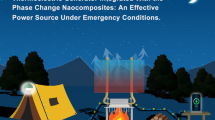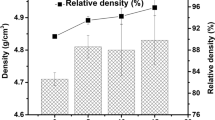Abstract
ZnO-based varistor ceramics were prepared at sintering temperatures ranging from 900 °C to 1,300 °C, by subjecting the mixed oxide powders to high-energy ball milling (HEBM) for 0, 5, 10 and 20 h, respectively. Varistor ceramics prepared by HEBM featured denser body, better electrical properties sintered at low-temperature than at traditional high-temperature. The high density is due to the refinement of the crystalline grains, the enhanced stored energy in the powders coming from lattice distortion and defects as well as the promotion of liquid-phase sintering. Good electrical properties is attributed to proper microstructure formed at low-temperature and improved grain boundary characteristics resulting from HEBM. With increasing sintering temperatures, the electrical properties and density became worse due to the decrease in amount of Bi-rich phase. Temperature increased up to 1,200 °C or above, the Bi-rich phase vanished and the ceramics exhibited very low nonlinear coefficient.







Similar content being viewed by others
References
Shirakawa S, Ejiri I, Watahiki S (1999) IEEE T Power Deliver 14:419
Shichimiya S, Yamaguchi M, Furuse N (1998) IEEE T Power Deliver 13:465
Shirakawa S, Yamada S, Tanaka S (2000) IEEE T Power Deliver 15:569
Imai T, Udagawa T, Ando H (1998) IEEE T Power Deliver 13:1182
Lauf Robert J, Bond Walter D (1984) Ceram Bull 63:278
Viswanath RN, Ramasamy S, Ramamoorthy R (1995) Nanostruct Mater 6:993
Duran P, Capel F, Tartaj J, Moure C (2002) Key Eng Mater 206–213:1389
Fah CP, Wang J (2000) Solid State Ionics 132:107
Alamdari HD, Boily S, Blouin M (2000) Mater Sci Forum 343–346:909
Pillai SC, Kelly JM, McCormack DE (2004) Mater Sci Tech 20:964
Pianaro SA, Bueno PR, Olivi P (1997) J Mater Sci Lett 16:634
Pianro SA, Bueno PR, Longo E, Varela JA (1998) J Mater Sci: Mater Electron 9:159
Li Changpeng, Wang Jinfeng, Su Wenbin (2001) Physica B 307:1
Morris William G (1976) J Vac Sci Technol 13:926
Bui A, Nguyen HT, Loubiere A (1995) J Phys D: Appl Phys 28:774
Leach C, Ling Z, Freer R (2000) J Eur Ceram Soc 20:2759
Olsson E, Dunlop GL (1989) J Appl Phys 66:3666
Alamdari HD (2000) In: Varistors Prepared from Nanocrystalline Powders Obtained by High-energy Ball Milling, Ph.D. Thesis, laval university, Canada, p 212
Acknowledgements
This work was supported by National Natural Science Foundation of China (Grant No.50471045) and Shanghai Nano-technology Promotion Center (Grant No.0452nm026).
Author information
Authors and Affiliations
Corresponding author
Rights and permissions
About this article
Cite this article
Liu, HY., Kong, H., Ma, XM. et al. Microstructure and electrical properties of ZnO-based varistors prepared by high-energy ball milling. J Mater Sci 42, 2637–2642 (2007). https://doi.org/10.1007/s10853-006-1350-7
Received:
Accepted:
Published:
Issue Date:
DOI: https://doi.org/10.1007/s10853-006-1350-7




